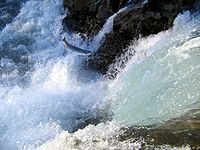
Photo from wikipedia
Large gulls are generalist predators that play an important role in Arctic food webs. Describing the migratory patterns and phenology of these predators is essential to understanding how Arctic ecosystems… Click to show full abstract
Large gulls are generalist predators that play an important role in Arctic food webs. Describing the migratory patterns and phenology of these predators is essential to understanding how Arctic ecosystems function. However, from all six large Arctic gull taxa, including three long-distance migrants, to date seasonal movements have been studied only in three and with small sample sizes. To document the flyways and migratory behaviour of the Vega gull, a widespread but little-studied Siberian migrant, we monitored 28 individuals with GPS loggers over a mean period of 383 days. Birds used similar routes in spring and autumn, preferring coastal to inland or offshore routes, and travelled 4000–5500 km between their breeding (Siberia) and wintering grounds (mainly the Republic of Korea and Japan). Spring migration mainly occurred in May, and was twice as fast and more synchronized among individuals than autumn migration. Migration bouts mainly occurred during the day and twilight, but rates of travel were always higher during the few night flights. Flight altitudes were nearly always higher during migration bouts than during other bouts, and lower during twilight than during night or day. Altitudes above 2000m were recorded during migrations, when birds made non-stop inland flights over mountain ranges and vast stretches of the boreal forest. Individuals showed high inter-annual consistency in their movements in winter and summer, indicating strong site fidelity to their breeding and wintering sites. Within-individual variation was similar in spring and autumn, but between individual variation was higher in autumn than in spring. Compared to previous studies, our results suggest that the timing of spring migration in large Arctic gulls is likely constrained by snowmelt at breeding grounds, while the duration of migration windows could be related to the proportion of inland versus coastal habitats found along their flyways (‘fly-and-forage’ strategy). Ongoing environmental changes are hence likely in short term to alter the timing of their migration, and in long term possibly affect the duration if e.g. the resource availability along the route changes in the future.
Journal Title: PLOS ONE
Year Published: 2023
Link to full text (if available)
Share on Social Media: Sign Up to like & get
recommendations!